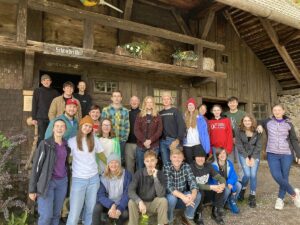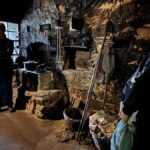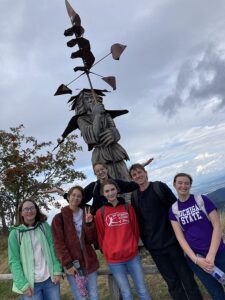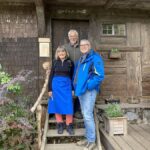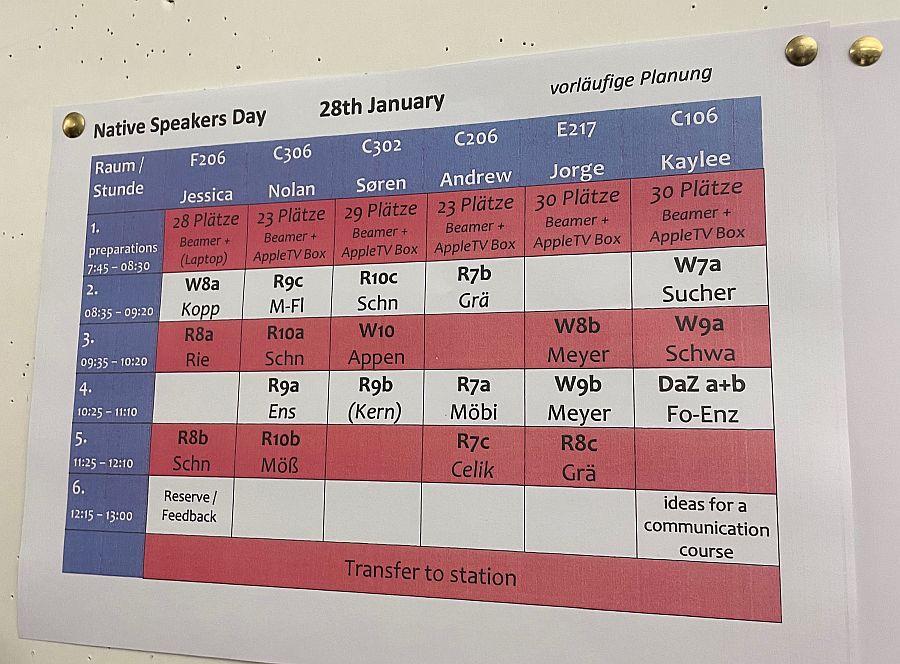
Native Speakers Day
2022-12-22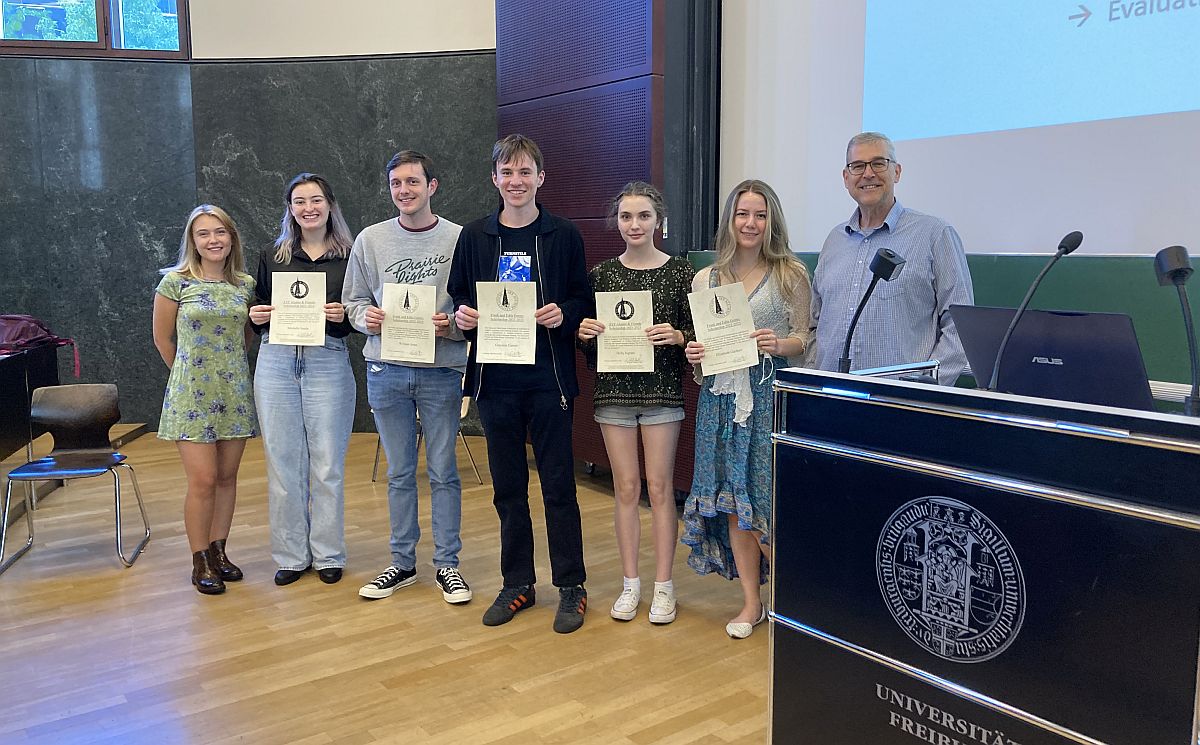
Alumni Club Updates & Scholarships 2022
2022-12-22400 Years of History
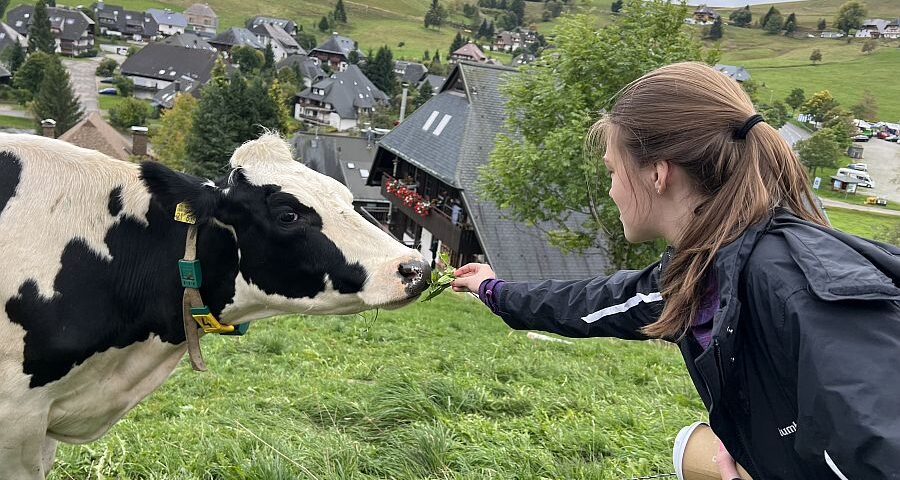
400 Years of History on Schauinsland
By Grayson Garner (AYF 2022-23, University of Iowa)
On the 24th of September the AYF group set off and traveled to Schauinsland for a day-long excursion consisting of hiking, sightseeing, and a tour of Schniederlihof. The day started at 11:30 at the Hauptbahnhof in Freiburg, but since I was still recovering from jetlag (yes, almost a month later), I arrived a bit early to grab a coffee to pep me up before our hike.
The train ride lasted about 40 minutes, but the anticipation of our destination made it seem as though it lasted 10. Upon arrival, we hopped off the train and directly onto a bus, which transported us up the mountain towards the beginning of our hike. The landscape changed with the increasing altitude, which was nice because the bottom of the mountain appeared as if we were traveling through the winding roads of the Rocky Mountains in Colorado. To an extent, it relieved some of my homesickness although my home state of Iowa lies a measly 13 hours away from the Rockies. Anyways, the further we went up, the more the trees dissipated and became an open mountain/forest town with some traditional wood houses with big windows and massive wooden beams that consisted, I assume, of the wood from the trees in Schwarzwald. Our bus then stopped at the entrance to the hiking trail, which coincidentally was next to the town’s Oktoberfest tent that was playing a 4 Non-Blondes remix.
The trail took us almost directly to Schniederlihof, leading us by a herd of cows. One of which greeted us by the fence with a sheepish “moo” and stood still enough for us to capture some pictures of both it and the town below. Upon arrival at Schniederlihof, Herr Lorenz greeted us, and we had the opportunity to purchase food and drink in a little room in the basement. My choice of the day was Räucherwurst with mustard, Gurken, and radishes, followed up with a slice of the cheesecake that was also made in-house. As I’ve only eaten warm Bratwurst in my life, the Räucherwurst was a nice change. It arrived cold, like Landjäger, but was just as delicious as any other Bratwurst I’ve had. Shortly after the tour started.
Ten of us went with Herr Lorenz inside of the door of the house and he gave us the option of English or German, which was nice because most people just switch to English to make it easier for both parties when talking
here. Although it was at some points hard to understand what was being said, most of the group could make out what Herr Lorenz was teaching us about the house. We traveled from one room to the next, learning that the ovens were the main heating source of the house after they moved on from the cows being the heat source (a lot less stinky).
The big main cooking oven laid in four separate rooms, allowing the heat from the oven to spread into all corners of the house, and the ventilation also worked its way throughout. This allowed the smoke to slowly envelop the wood of the house and reinforce it, creating a charred appearance that was as hard as stone, hence why it is called a “smoking house”. As we worked our way into the stables where the family kept the chickens and cows, we started the see the effects of the smoke. The wood from the bedroom started appearing increasingly black and charred and became darker as we got near the tool shed and the kitchen. It came as no surprise that the tool room contained woodcutting instruments. The name behind “Räucherwurst” became apparent when we got to the kitchen. Strings of sausages hung from the ceiling of the black room and Herr Lorenz demonstrated for us how the smoke ventilation worked when the family still lived in the house. Just like the wood, the sausages were preserved by means of smoke, only without the fancy smokers that people use today.
From Schniederlihof we continued the next part of our hike. Through light rain we hiked further up the mountain, passing a herd of goats and the Engländerdenkmal. I had heard about the English Calamity before, the “Engländerunglück” if I remember correctly, but never realized that the incident had occurred on Schauinsland. It was surprising to see something that I had learned in a previous German class in real life.
A little farther up the mountain, there was a huge woodcarving of “der Windbohrer” that looked down upon the general area in Schauinsland. We then summitted at the top of our hike… unfortunately the Turm on the top was closed to the public. The descent back down the other side was a lot easier than the ascent up; sadly, the cable car was out of use for the day as well (another thing we can thank Covid for since it couldn’t operate due to lack of staff!!!). We concluded our excursion with another beautiful bus ride back down the mountain.
Thankfully the sun came out of hiding; everything shone in a warm light and appeared as if it were the first glimpse of fall. My favorite part was the stream that seemed to guide the roads back down the mountain. The train ride back to Freiburg was much like the train ride from Freiburg. Everyone was expelled of their energy from the hike, and some slept the entire way back.
Looking back on the trip, I can say with confidence that Schauinsland was my personal favorite of the three excursions that AYF took during the orientation period. Basel was amazing and had a wonderful old city and an even better antiquities museum, and Colmar was a lovely introduction to France, but nothing beats the monuments and tour of Schniederlihof that Schauinsland presented for us.
Addendum: Ulli Struve, Program Director, would like to add a note of appreciation and gratitude to Herr and Frau Lorenz and their team for offering an historical introduction to the hard-scrabble farm life above the tree line on Schauinsland for the last 15 years. Generations of AYFers – and several Reunion groups! – have enjoyed their tours and hospitality with a Vesperbrett and the most fabulous Zwetschgenkuchen. A heartfelt “Thank you!” on behalf of AYF and the many AYFers and JYF alumni you have hosted over the years!
As of this writing, the future fate of Schniederlihof as a farm museum is up in the air. The municipality of Oberried has been posting job ads for a new minder and guide, so far without success. Are the expectations too high? The offered compensation inadequate? Or simply no one available? We do not know. Staffing is hard to find, these days. We do know, however, that it would be a great pity if this wonderful museum, clearly of more than local importance, were to be permanently shuttered for lack of funding and vigorous municipal support. If you have especially fond memories of your visit to Schniederlihof and would like to express your sentiments, surely Herr Klaus Vosberg, the Mayor of Oberried, would be delighted to receive some American correspondence and encouragement.


